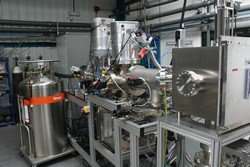A biomass-to-liquid plant to produce sustainable synthetic fuel

An EU project developed innovative nanocatalysts to create an integrated modular and highly efficient process for producing fuels from renewable energy sources.
Climate change and a growing population necessitate the use of more sustainable energy sources. While this problem represents a significant societal demand, it is only one of many the petrochemical industry faces. Increased competition and dependency from external sources, rising costs, and the pressure to reduce the environmental impact of the processes employed are some other challenges that this industry currently has to overcome.
To satisfy its environmental, economic and societal responsibilities, the industry needs to develop sustainable fuel production methods. Fifteen partners across eight countries joined efforts in the EU-funded project BIOGO-FOR-PRODUCTION to radically transform production processes and realise these essential improvements.
Turning biogas into gasoline
The project focused on developing an integrated, coherent and holistic approach for transforming biofuel production from sustainable sources. Project partners utilised novel technology to prepare nanoscale catalysts with reduced dependence on precious metals and rare earth materials as well as innovative industrial methods for every production step.
"In BIOGO-FOR-PRODUCTION, we have devised a process for converting renewable bio-oils and biogas to synthesis gas, which is then catalytically transformed to biofuels and chemical platform products. This sustainable process is independent of fossil fuels," says project coordinator Gunther Kolb. Researchers used a hydrogen-enriched biogas that was readily converted into synthesis gas via autothermal or combined exothermic and endothermic routes. The excess hydrogen and heat were used to transform pyrolysis oil into additional synthesis gas to ultimately yield a composition suitable for methanol synthesis. Through suitable catalysts, methanol was then converted into a liquid fuel—synthetic gasoline.
Producing synthetic fuels from renewable sources will make an extremely valuable contribution to sustainably meeting energy demands. "Unlike the conventional Fischer-Tropsch process currently in use for producing synthetic hydrocarbon fuels, BIOGO-FOR-PRODUCTION's process chain promises higher carbon efficiency, energy efficiency, security of supply as well as cost benefits," adds Gunther.
Nanotechnology for biofuels
Project partners worked on improving the available catalysts for each of the four key steps of the production process. Innovative techniques were applied to improve overall performance such as cluster beam sputtering. This technique involves ejecting small clusters of atoms on to the surface of a carrier material with a high surface area. The newly developed stable catalysts limited the formation of light hydrocarbons, especially methane.
The team also developed a new system that boasts a much higher deposition rate of nano-clusters, about two to three orders of magnitude higher than a typical research-grade system that can be currently found in university laboratories. This makes it much more suitable for use in the industry.
BIOGO-FOR-PRODUCTION demonstrated its process chain still on a small scale. The miniplant operates in a container environment suited for chemicals production and can serve as a future host for modular fuel production plants. Researchers have also run a pilot-scale catalyst production and demonstrated its manufacturing potential for fast industrialisation.
Provided by CORDIS




















